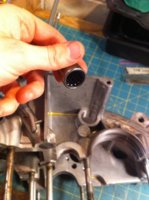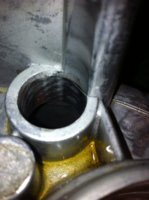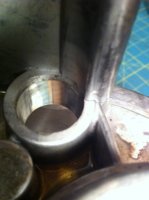abyssmaltailgate
Greenhorn Mechanic
I've been meaning do deal with this awhile, and believe I've found a solution, but decided I'd review the forum to see what information I could find out there (if any) about a crack in this particular spot of the upper engine case:
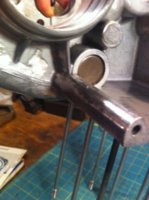
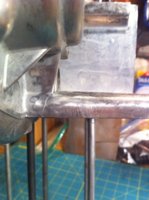
Obviously that top case is upside down, but this hairline crack extends from the portion of the case that meets with the primary drive (left hand) cover to the where the gear selector drum articulates in the left hand side of the case. My assumption is this crack possibly occurred after a lot of hard, clunky shifting.
My question is twofold: the first regarding how to repair the crack, and the second addressing how to potentially avoid future cracking.
In regards to repairing the crack, I was thinking about TIG welding the aluminum at about 20 - 30 volts with maybe a little bit of pulse since I know how easily engine cases (and aluminum in general) will liquefy; I'd use some pretty skinny filler rod too. Additionally, I'm used to repairing cracks in cast steel by drilling holes at each end of the crack so they don't grow while welding or after welding (due to incomplete fusion). I'm not sure if that's a wise idea here. Furthermore, I'm concerned if welding the crack in the first place is smart. Potentially, I'd assume there's a risk of melting and clogging local internal oil galleries and the metal expanding and shrinking, pinching the bearings where the gear selector drum articulates. Lastly, if I drill it in attempt to stop the crack, will I mess up the cases even more?
Basically, what I'm asking is 1) is it worth welding the case in this location and 2) should I drill the ends of the crack or just weld over the crack if I do weld it?
Finally, pertaining to preventing the crack in the future; this engine is a '74 XS650 B and came stock with a two-piece clutch push rod (at least that's what I removed when I stripped it). I've got a one-piece push rod I intend to install when I ultimately rebuild it. I understand the one-piece rod has smoother shifting action... I guess I'm hoping to confirm the one-piece may better protect the cases from clunky shifting and cracking better than the two-piece?
I'm looking forward to all you gurus and other shade tree mechanics chiming in...


Obviously that top case is upside down, but this hairline crack extends from the portion of the case that meets with the primary drive (left hand) cover to the where the gear selector drum articulates in the left hand side of the case. My assumption is this crack possibly occurred after a lot of hard, clunky shifting.
My question is twofold: the first regarding how to repair the crack, and the second addressing how to potentially avoid future cracking.
In regards to repairing the crack, I was thinking about TIG welding the aluminum at about 20 - 30 volts with maybe a little bit of pulse since I know how easily engine cases (and aluminum in general) will liquefy; I'd use some pretty skinny filler rod too. Additionally, I'm used to repairing cracks in cast steel by drilling holes at each end of the crack so they don't grow while welding or after welding (due to incomplete fusion). I'm not sure if that's a wise idea here. Furthermore, I'm concerned if welding the crack in the first place is smart. Potentially, I'd assume there's a risk of melting and clogging local internal oil galleries and the metal expanding and shrinking, pinching the bearings where the gear selector drum articulates. Lastly, if I drill it in attempt to stop the crack, will I mess up the cases even more?
Basically, what I'm asking is 1) is it worth welding the case in this location and 2) should I drill the ends of the crack or just weld over the crack if I do weld it?
Finally, pertaining to preventing the crack in the future; this engine is a '74 XS650 B and came stock with a two-piece clutch push rod (at least that's what I removed when I stripped it). I've got a one-piece push rod I intend to install when I ultimately rebuild it. I understand the one-piece rod has smoother shifting action... I guess I'm hoping to confirm the one-piece may better protect the cases from clunky shifting and cracking better than the two-piece?
I'm looking forward to all you gurus and other shade tree mechanics chiming in...


